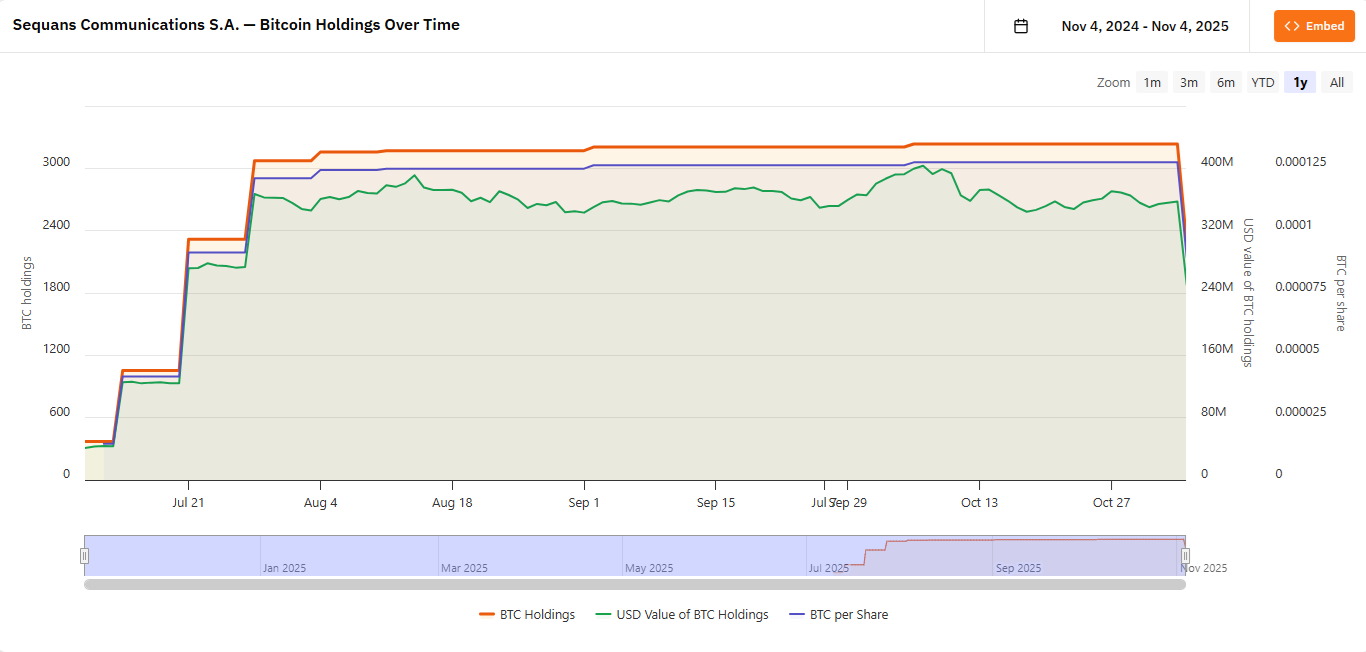Sequans Communications (SQNS) became the first Bitcoin treasury company to sell coins for debt servicing, offloading 970 BTC amid shaky market prices. This strategic move redeemed 50% of its convertible debt, improving financial flexibility while retaining a conviction in Bitcoin as a long-term reserve asset.
-
Sequans sold 970 BTC to balance debt and assets.
-
The sale reduced the debt-to-net asset value ratio from 55% to 39%.
-
Post-sale, Sequans holds 2,264 BTC, down from a peak of 3,324 BTC earlier in 2025.
Sequans Communications Bitcoin sale marks a shift for treasury firms. Learn how SQNS sold 970 BTC to service debt, optimizing finances in a volatile market. Discover implications for playbook companies—read now for expert insights.
What is Sequans Communications’ Bitcoin Treasury Strategy?
Sequans Communications’ Bitcoin treasury strategy involves holding Bitcoin as a long-term strategic reserve asset while making tactical adjustments to manage debt and enhance shareholder value. The French firm, part of the emerging group of playbook companies inspired by MicroStrategy, began accumulating Bitcoin in July 2025 with an initial 370 BTC, peaking at 3,324 BTC. Recently, it sold 970 BTC to redeem 50% of its convertible debt, demonstrating a balanced approach to financial flexibility without abandoning its core conviction in the cryptocurrency.
How Did Sequans Communications Adjust Its Debt-to-Asset Ratio Through Bitcoin Sales?
Sequans Communications executed a strategic asset reallocation by selling 970 BTC, which directly improved its debt-to-net asset value (NAV) ratio from 55% to 39%. This adjustment, announced on November 4, 2025, allowed the company to enhance financial flexibility, reduce debt constraints, and increase capacity for share buybacks. According to company disclosures, the move preserved long-term treasury optionality, with Sequans retaining 2,264 BTC post-sale. CEO Georges Karam emphasized that this was a tactical decision amid current market conditions, stating, “Our Bitcoin treasury strategy and our deep conviction in Bitcoin remain unchanged.” He further noted, “This transaction was aimed at unlocking shareholder value… enabling us to pursue a wider set of strategic initiatives to prudently develop and grow our treasury, with Bitcoin as a long-term strategic reserve asset.” Data from Bitcoin Treasuries tracking shows this sale occurred as Bitcoin prices slid below $102,000, influenced by profit-taking from large holders. The playbook model, adopted by 18 companies including Sequans, typically converts debt and stock issuance into Bitcoin holdings, but Sequans’ action sets a precedent for selective sales during bearish phases. This is not isolated; similar moves, like EthZilla’s partial ETH sale for buybacks, highlight evolving treasury management in crypto cycles.
Sequans Redeems 50% of Convertible Debt Through Strategic Asset Reallocation.
This move opportunistically leverages Bitcoin holdings to enhance financial flexibility, reduce Debt-to-NAV ratio, and boost buyback capacity while preserving long-term treasury optionality. $SQNS
Learn… pic.twitter.com/bTbVMQGC2T— Sequans (@Sequans) November 4, 2025
Sequans Communications (SQNS) is the first Bitcoin treasury company to sell coins in order to balance its debt. The company sold 970 BTC at a time when market prices remained shaky. Sequans Communications (SQNS) sold 970 BTC from its treasury to service debt. Sequans is starting a precedent among playbook companies in selling their treasuries to improve asset balance. Following the news of the sale, BTC traded under $102,000, extending its slide in line with bearish expectations.
The French firm is one of the 18 ‘playbook companies’, which copy the moves of MicroStrategy to turn debt and stock issuance into BTC. Sequans announced its round of ‘strategic asset reallocation’, where it redeemed 50% of convertible debt.
After the sale, Sequans holds 2,264 BTC. The company started its treasury with just 370 BTC in July 2025, building up to 3,324 BTC at the peak.
 Sequans sold BTC from its treasury to erase 50% of its debt, just as BTC was sliding to a lower range. | Source: Bitcoin Treasuries
Sequans sold BTC from its treasury to erase 50% of its debt, just as BTC was sliding to a lower range. | Source: Bitcoin TreasuriesSequans follows the recent move of EthZilla to sell a part of its ETH holdings for share buybacks. There is currently no standard for treasury companies to retain all their holdings, even when conditions worsen. The playbook approach works during bullish parts of the crypto cycle, but this time, the willingness of treasury companies to hold may be tested.
Frequently Asked Questions
What prompted Sequans Communications to sell 970 BTC from its treasury?
Sequans Communications sold 970 BTC to redeem 50% of its convertible debt as part of a strategic asset reallocation. This tactical move, executed in November 2025, aimed to improve the debt-to-NAV ratio from 55% to 39%, enhance financial flexibility, and unlock shareholder value amid volatile Bitcoin prices below $102,000, according to company statements.
Is Sequans Communications still committed to Bitcoin as a treasury asset?
Yes, Sequans Communications maintains a strong commitment to Bitcoin as a long-term strategic reserve asset. CEO Georges Karam confirmed that the recent sale was purely tactical and did not alter the company’s deep conviction in Bitcoin’s value, with plans to continue growing the treasury prudently for future initiatives.
Key Takeaways
- Precedent for Treasury Sales: Sequans Communications is the first playbook company to sell Bitcoin holdings for debt servicing, potentially influencing other firms facing financial pressures.
- Improved Financial Metrics: The sale reduced the debt-to-NAV ratio to 39%, boosting buyback capacity and removing debt constraints, as evidenced by Q3 financials showing adjusted losses.
- Market Context Insight: With Bitcoin trading under $102,000 and SQNS shares at an all-time low of $6.22, treasury strategies may evolve in bearish conditions—monitor playbook companies for adaptive actions.
Conclusion
Sequans Communications’ Bitcoin sale underscores a pragmatic evolution in treasury management for playbook companies, balancing debt obligations with long-term Bitcoin treasury strategy convictions. By redeeming 50% of convertible debt through this reallocation, SQNS not only strengthened its financial position but also highlighted the flexibility needed in volatile crypto markets. As Bitcoin prices stabilize and treasury practices mature, firms like Sequans will likely continue integrating such tactics—stay informed on emerging trends to navigate the dynamic landscape of corporate cryptocurrency adoption.
